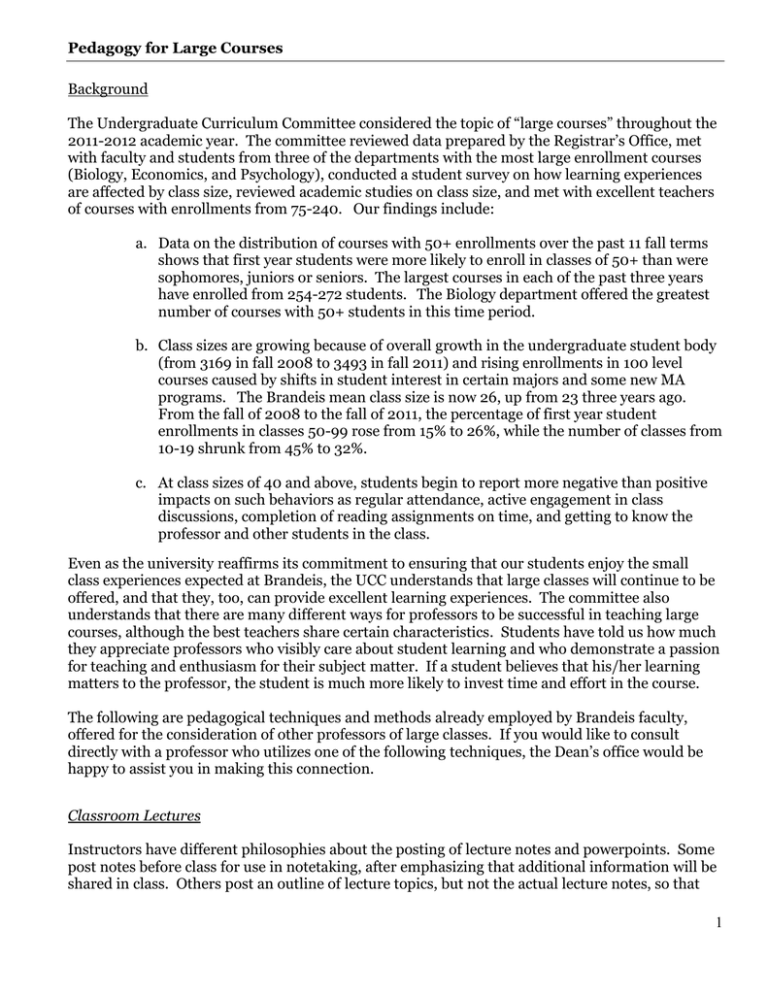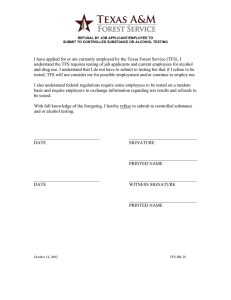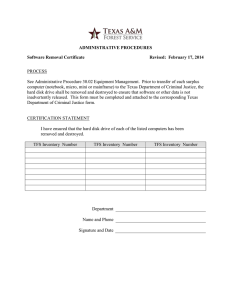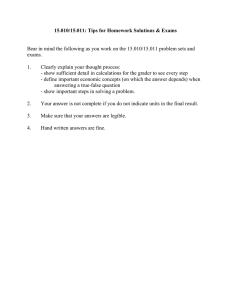Background The Undergraduate Curriculum Committee considered the topic of “large courses” throughout... Pedagogy for Large Courses
advertisement

Pedagogy for Large Courses Background The Undergraduate Curriculum Committee considered the topic of “large courses” throughout the 2011-2012 academic year. The committee reviewed data prepared by the Registrar’s Office, met with faculty and students from three of the departments with the most large enrollment courses (Biology, Economics, and Psychology), conducted a student survey on how learning experiences are affected by class size, reviewed academic studies on class size, and met with excellent teachers of courses with enrollments from 75-240. Our findings include: a. Data on the distribution of courses with 50+ enrollments over the past 11 fall terms shows that first year students were more likely to enroll in classes of 50+ than were sophomores, juniors or seniors. The largest courses in each of the past three years have enrolled from 254-272 students. The Biology department offered the greatest number of courses with 50+ students in this time period. b. Class sizes are growing because of overall growth in the undergraduate student body (from 3169 in fall 2008 to 3493 in fall 2011) and rising enrollments in 100 level courses caused by shifts in student interest in certain majors and some new MA programs. The Brandeis mean class size is now 26, up from 23 three years ago. From the fall of 2008 to the fall of 2011, the percentage of first year student enrollments in classes 50-99 rose from 15% to 26%, while the number of classes from 10-19 shrunk from 45% to 32%. c. At class sizes of 40 and above, students begin to report more negative than positive impacts on such behaviors as regular attendance, active engagement in class discussions, completion of reading assignments on time, and getting to know the professor and other students in the class. Even as the university reaffirms its commitment to ensuring that our students enjoy the small class experiences expected at Brandeis, the UCC understands that large classes will continue to be offered, and that they, too, can provide excellent learning experiences. The committee also understands that there are many different ways for professors to be successful in teaching large courses, although the best teachers share certain characteristics. Students have told us how much they appreciate professors who visibly care about student learning and who demonstrate a passion for teaching and enthusiasm for their subject matter. If a student believes that his/her learning matters to the professor, the student is much more likely to invest time and effort in the course. The following are pedagogical techniques and methods already employed by Brandeis faculty, offered for the consideration of other professors of large classes. If you would like to consult directly with a professor who utilizes one of the following techniques, the Dean’s office would be happy to assist you in making this connection. Classroom Lectures Instructors have different philosophies about the posting of lecture notes and powerpoints. Some post notes before class for use in notetaking, after emphasizing that additional information will be shared in class. Others post an outline of lecture topics, but not the actual lecture notes, so that 1 students must attend class to hear/experience the lecture. Others post lecture notes only when they need to clarify or better explain a topic. Ask students to make large place cards with their names written on them in markers so that you can read names and call on students in class. Consider using real life problems as examples. Offer different examples and ways of explaining problems and solutions that are not found in the readings. Recognizing that attention spans are limited, consider lecturing in small chunks of 20 minutes or so. For a change of pace, utilize videos, photos, a portion of a new text, worksheets, anecdotes, musical selections, etc. in between lecture “chunks.” Use different forms of pedagogy once a week (e.g., show part of a movie on Friday) to break up the routine. Ask frequent questions to find out if the students are “staying” with you and to encourage student engagement, active learning, and faculty-student interaction. Pause frequently to ask if students have questions or comments. Minimize reading from powerpoint slides or the textbook. Consider taking attendance by asking for student signatures on a list of students enrolled in the course, or check attendance by reading out 10 to 15 names selected at random, once a week, or more or less frequently. State your laptop policy in your syllabus, and also announce it in class. Active Learning Pedagogy Use the "Just-in-Time-Teaching" model (hyperlinks below), by asking students to write a comment about the reading the night before each class session (e.g., What in the reading didn’t you understand? Or What did you find most interesting?). By reviewing these comments, perhaps collated by TFs, the instructor comes to class knowing what was unclear or exciting about the reading, which enables a new level of conversation with students. The comments can be anonymous or not (depending on how you set it up); if not anonymous, you can ask a student by name to repeat the comment in class (for sensitive subjects, anonymity is better). Some instructors also post the comments on the screen. Professors using the "Just-in-Time-Teaching" model in classes larger than 75 at other schools, use multiple choice questions to quickly learn what students are understanding. You can also split the class into groups, so that each student only submits her comments once per week. http://serc.carleton.edu/introgeo/justintime/ http://www.indiana.edu/~rcapub/v22n1/p08.html Utilize “think pair share,” asking students to take a minute to think individually about a question, then pair and discuss with a partner, before calling on students to share with the entire class what was discussed in the pair. Click here for additional information. 2 Ask all students to close their eyes, and then answer a question by raising their hands, as a way of checking in on student understanding without embarrassing students. Or use the “cough test.” For example, if an instructor wants to find out who did the reading, say “Let’s do a cough test.” Turn to the board, so you cannot see the class, and say: “Cough if you did the reading [pause for coughs]… cough if you did not do the reading [pause for coughs].” This way everyone gets the feedback, not just the teacher – which is often very comforting, if you were one of the 2/3 of students who didn’t read. And, the cough test almost invariably causes relief and amusement, warming up the class. To engage students within a lecture and to provide instant in-class formative assessment, have students utilize “clickers” or “audience response systems,” which are hand-held devices (purchased through the Bookstore) allowing students to answer questions, with the cumulative student response then posted on screen. The best “higher level” clicker questions have more than one viable answer to target misconceptions and make students think. Some instructors ask students to discuss their answers in small groups before re-polling. Utilize “post class musings” through an online form or “minute papers” at the end of class asking “What did you find most interesting, or most confusing?” to learn what students are not understanding. You may wish to utilize Google Forms to retrieve students’ questions/comments, because all of the answers can be stored in one place. Sections/TFs/TAs In large classes, assign each student alphabetically to a 20-25 student section, which meets every other week, six to seven times per semester, in one of the course’s hour-long or 90 minute meeting blocks. Ask students to post possible discussion topics in LATTE the night before the section meets. Have TFs meet to assemble a common, student generated agenda (allow some flexibility in addressing topics). Require TFs to be available to review drafts of papers, and also grade that section’s papers. If graduate student TFs are not available to lead sections, consider utilizing undergraduate peer teaching assistants, who might receive PEER 94 credit or be paid for their work. Undergraduate TAs would be supervised through regular meetings with the course instructor, but would not grade papers. A few times during the semester, distribute a set of five questions at the beginning of class and then divide the class into small “leaderless” groups for 20 minutes of discussion, before bringing the entire class back together for group reporting. Offer optional or required evening recitation or review sessions, listed in the course schedule as a required time block (and the time when exams are scheduled). During the weekly recitation hours, offer Structured Study Groups, or sections of 40 students led by undergraduate TAs, who give peer reviewed quizzes. Have students work in small TA supervised groups to decide on quiz answers, in order to learn applications/content and prep for exams. Visit each of the section meetings once, and ask the students to introduce themselves again to you. Exams/Grading 3 Post previous exams with two answers (one correct and one wrong one, or one strong and one weak one, which exemplify students’ misunderstandings from previous exams) to each question, and require students to respond with comments on what is wrong about the incorrect answer. This assignment helps students understand potential mistakes better than supplying an answer key, which might be memorized, without real understanding. “Blind-grade” exams, and ensure that the professor and TFs grade by using the same standards or rubric. Base exams on what is taught during class lectures, including material not posted in lecture notes/powerpoints. Count participation (attendance in very large classes, and/or participation in sections, and/or contributing comments to an online forum) as 10% (or some other percentage) of the course grade. Offer an “extra credit” written question and ask the students (take first two-four) to come to the front of the class and share their answers. Out of Class Interaction Utilize vouchers offered by the Dean’s Office to take first year students to lunch or participate in the “Take a Professor to Lunch” program when asked. Invite or require all students to meet with you during office hours (depending on the size of your class, in groups of three or in groups of 10, scheduled at specific times in a nearby classroom) just to introduce themselves. Students might be asked to come at scheduled times with “three questions about anything, not necessarily related to the course.” Announce that you will eat breakfast or lunch in Sherman or Usdan once a week/month and invite all (or all first year) students to meet with you, perhaps by sign-up. Organize a class activity which facilitates interaction outside of the classroom (for example, visit the Rose Art Museum or a Waltham community agency together). Discussion Items for Departments/Chairs with Many Large Classes Consider capping some courses at 20-25, while allowing other classes to grow to 50, 75, or larger, to ensure that the department provides every student with the option of taking one or more smaller classes. Students feel strongly that professors should make an effort to learn their students’ names in all classes, but especially in classes of 20-25; they recognize that learning names becomes more difficult as class size grows. In our surveys, the students’ top preference for improving large classes, selected from among several options, was the addition of smaller discussion sections. In classes with 60 or more students, consider assigning each student alphabetically to a 20-25 student section, which meets every other week, six to seven times per semester, in one of the course’s hour-long or 90 minute meeting blocks. These sections can be led by TFs or peer TAs, who meet before each section meeting with the professor to review discussion topics or main points. 4



